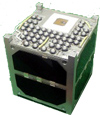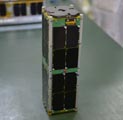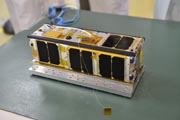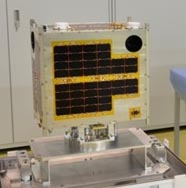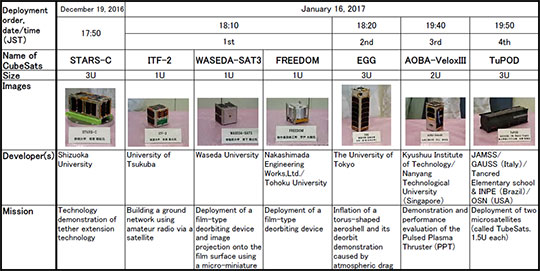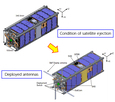This is an archive of information released in the past.
Disclaimer: It may contain broken links or outdated information. Some parts may not function in current web browsers.
*Visit https://humans-in-space.jaxa.jp/en/ for the latest information.

Experiment
- News
- Kibo Utilization Strategy
- Kibo Utilization Plan
- List of JAXA's Utilization Themes
- Experiment Facilities
- Space Environment Utilization
- Archive
List of deployed CubeSats using J-SSOD
| No | Deploy No | Release date | Release time | Organization | Size |
|---|---|---|---|---|---|
| 1 | 2 | October 4, 2012 | 11:37 pm | WE WISH (Meisei Electric Co.,Ltd.), RAIKO (Tohoku University/ Wakayama University) |
1U 2U |
| 3 | October 5, 2012 | 0:44 am | FITSAT-1 (Fukuoka Institute of Technology), F-1 (NanoRacks/ FPT University/ UPPSALA University), TechEdSat (NASA Ames Research Center (ARC)/ San Jose State University) |
1U | |
| 2 | 3 | November 19, 2013 | 9:17 pm | PicoDragon (The University of Tokyo (Japan)/ Vietnam National Satellite Center/ IHI AEROSPACE Co.,Ltd.), ArduSat-1 & ArduSat-X (NanoRacks LLC/ NanoSatisfi) |
1U |
| 1 | November 20, 2013 | 4:58 pm | TechEdSat-3 (NASA Ames Research Center (ARC)) | 3U | |
| 3 | 1 | February 5, 2015 | 9:50 pm | AESP-14 (Aeronautics Institute of Technology (ITA)/ National Institute For Space Research (INPE)/ Brazilian Space Agency (AEB)) | 1U |
| 4 | 1 | September 17, 2015 | 9:02 pm | S-CUBE (Chiba Instiute of Technology) | 3U |
| 1 | 9:12 pm | SERPENS (University of Brasilia/ Brazilian Space Agency (AEB)) | 3U | ||
| 5 | 1 | April 27, 2016 | 8:45 pm | DIWATA-1 (Department of Science and Technology (DOST)/ University of the Philippines/ Tohoku University/ Hokkaido University) | 50kg class |
| 6 | 1 | December 19, 2016 | 5:50 pm | STARS-C (Shizuoka University) | 2U |
| 3 | January 16, 2017 | 6:10 pm | ITF-2 (University of Tsukuba), WASEDA-SAT3 (Waseda University), FREEDOM (Nakashimata Engineering Works,Ltd./ Tohoku University) |
1U | |
| 1 | 6:20 pm | EGG (The University of Tokyo (Japan)) | 3U | ||
| 1 | 7:40 pm | AOBA-VeloxIII (Kyushu Institute of Technology (Japan)/ Nayang Technological University (Singapore)) | 2U | ||
| 1 | 7:50 pm | TuPOD (JAMSS/ GAUSS (Italy)/ Tancred Elementary School & INPE (Brazil)/ OSN (USA)) | 3U | ||
| 7 | 5 | July 7, 2017 | 5:50 pm | TOKI (Kyushu Institute of Technology (Japan)), GhanaSat1 (All Nations University College (ANUC) (Ghana)), Mazaalai (National University of Mongolia (Mongol)) |
1U |
| 6:10 pm | BRAC Onnesha (BRAC University (Bangladesh)), Nigeria Edusat1 (Federal University of Technology, Akure (Nigeria)) |
1U | |||
| 8 | 2 | May 11, 2018 | 7:30 pm | Irazu (Costa Rica Institute of Technology (Costa Rica) / ACAE (*1)) (*1)Central American Association of Aeronautics and Space, 1KUNS-PF (The University of Nairobi (Kenya)) |
1U |
| 1 | 7:40 pm | UBAKUSAT (Istanbul Technical University (Turkey)) | 3U | ||
| 9 | 3 | August 10, 2018 | 6:45 pm | BHUTAN-1 (Royal University of Bhutan), MAYA-1 (University of the Philippines), UiTMSAT-1 (MARA University of Technology of Malaysia) |
1U |
| 10 | 1 | October 6, 2018 | 4:45 pm | SPATIUM-I (Nanyang Technological University (Singapore)/ Kyushu Institute of Technology (Japan)) | 2U |
| 1 | 5:00 pm | RSP-00 (Ryman Sat Spaces General Incorporated Association) | 1U | ||
| 1 | 5:00 pm | STARS-Me (Shizuoka University) | 2U | ||
| 11 | 3 | June 17, 2019 | 7:15 pm | NepaliSat-1 (Nepal Academy of Science and Technology (NAST; Nepal) and Kyushu Institute of Technology (Japan)) | 1U |
| Raavana-1 (Arthur C Clarke Institute of Modern Technologies (ACCIMT; Sri Lanka), and Kyushu Institute of Technology (Japan)) | 1U | ||||
| Uguisu (Kyushu Institute of Technology (Japan)) | 1U | ||||
| 1 | 7:20 pm | SpooQy-1 (Singapore Space and Technology Association (SSTA) and National University of Singapore(Singapore)) | 3U | ||
| 12 | 1 | November 20, 2019 | 5:55 pm | RWASAT-1 (The University of Tokyo (Japan)/Ministry of Commerce, Industry, & Tourism Rwanda Utilities Regulatory Authority Smart Africa secretariat (Republic of Rwanda)) | 3U |
| 1 | 6:10 pm | NARSSCube-1 (Kyushu Institute of Technology (Japan)/National Authority for Remote Sensing and Space Science (NARSS)) | 1U | ||
| 1 | 6:25 pm | AQT-D (Space BD Inc./The University of Tokyo (Japan)) | 3U |
Number of satellites: 41(total)
1. Technology validation mission
Carried by: H-II Transfer Vehicle KOUNOTORI3 (HTV3)
Deployed: October 4-5, 2012
2.
Carried by: H-II Transfer Vehicle KOUNOTORI4 (HTV4)
Deployed: November 19-20, 2013
| Name | PicoDragon | ArduSat-1 | ArduSat-X | TechEdSat-3 |
|---|---|---|---|---|
| Image | 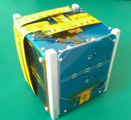 |
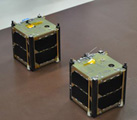 |
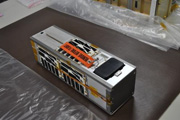 |
|
| Size | 1U | 1U | 1U | 3U |
| Organization | The University of Tokyo (Japan)/ Vietnam National Satellite Center/ IHI AEROSPACE Co.,Ltd. | NanoRacks LLC/ NanoSatisfi | NASA Ames Research Center (ARC) | |
| Mission | Earth imaging | Technology validation of an open platform that has re-programming function. (Activation of applications uplinked by general people) | Technology validation of the aero braking mechanism called Exo-brake on its deorbiting. | |
| Sponsoring agency | JAXA | NASA | ||
3.
Carried by: Dragon spacecraft (Spx-5)
Deployed: February 5, 2015
| Name | AESP-14* |
|---|---|
| Image | 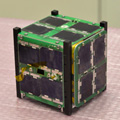 |
| Size | 1U |
| Organization | Technological Institute of Aeronautics (ITA)/ National Institute For Space Research (INPE)/ Brazilian Space Agency (AEB) |
| Mission | Amateur Radio Experiment |
* AESP-14 takes an opportunity of Kibo's paid utilization and is deployed by Japan Manned Space Systems Corporation (JAMSS) at the request of Brazilian Space Agency (AEB).
4.
Carried by: H-II Transfer Vehicle KOUNOTORI5 (HTV5)
Deployed: September 17, 2015
| Name | SERPENS | S-CUBE |
|---|---|---|
| Image |
(JAXA/ University of Brasilia/ |
(JAXA/ Chiba Instiute of Technology) |
| Size | 3U | 3U |
| Organization | University of Brasilia/ Brazilian Space Agency (AEB) |
Chiba Instiute of Technology |
| Mission | Technology Demonstration of a Meteorological Data Collecting System by ground-based Sensors | Satellite for observation of meteor's ultraviolet rays |
5.
Carried by: Cygnus spacecraft (OA-6)
Deployed: April 27, 2016
| Name | DIWATA-1 |
|---|---|
| Image |
|
| Size | 55cm×55cm×35cm |
| Organization | Department of Science and Technology (DOST)/ University of the Philippines/ Tohoku University/ Hokkaido University |
| Mission | Demonstrates natural resources and disaster monitoring in the Philippines with the first microsatellite in the country |
6.
Carried by: H-II Transfer Vehicle KOUNOTORI6 (HTV6)
Deployed: December 19, 2016/ January 16, 2017
- Successful deployment of a CubeSat delivered by KOUNOTORI6
- Successful deployment of six CubeSats delivered by KOUNOTORI6
7.
Carried by: SpaceX CRS-11 (SpX-11)
Delivered to the International Space Station (ISS) onboard the Space X CRS-11 (SpX-11) launched on June 4, 2017, five CubeSats were successfully deployed on July 7, 2017 from Japanese Experiment Module “Kibo” after completing deployment preparations.
8.
Carried by the Space X CRS-14 (SpX-14)
Delivered to the ISS onboard the Space X CRS-14 (SpX-14) launched on April 3, 2018, three CubeSats were successfully deployed on May 11, 2018 from the Japanese Experiment Module “Kibo” after completing deployment preparations.
9.Mounted on Dragon Spacecraft Spx-15 (SpX-15)
The Dragon spacecraft (SpX-15), launched on June 29, 2018, carried these ultra-small satellites to the International Space Station (ISS), where they underwent preparative operations first and then were deployed together on August 10, 2018 (JST).
| Name | BHUTAN-1 | MAYA-1 | UiTMSAT-1 |
|---|---|---|---|
| Image | 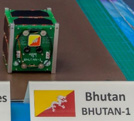 |
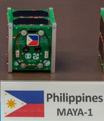 |
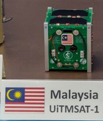 |
| Size | 1U | 1U | 1U |
| Organization | Royal University of Bhutan | University of the Philippines | MARA University of Technology of Malaysia |
| Missions |
|
||
10.CubeSats delivered by KOUNOTORI7 (HTV7)
These CubeSats were delivered to the International Space Station (ISS) by the H-II transfer vehicle KOUNOTORI7 (HTV7) which were launched on September 23, 2018 (JST). They underwent a preparative operation and were deployed on October 6, 2018 (JST).
| Name | SPATIUM-I | RSP-00 | STARS-Me |
|---|---|---|---|
| Image |  |
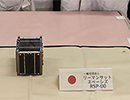 |
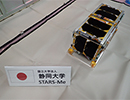 |
| Size | 2U | 1U | 2U |
| Organization | Nanyang Technological University (Singapore) / Kyushu Institute of Technology (Japan) | Ryman Sat Spaces General Incorporated Association (Japan) | Shizuoka University (Japan) |
| Mission | A demonstration of technologies in view of a chip-scale atomic clock to be mounted on CubeSat and measurement/3D mapping of the densities of electrons in the ionosphere |
|
|
11. Carried by:Cygnus Spacecraft (NG-11)
Delivered on board the NG-11 Cygnus to the International Space Station on April 18, 2019, four CubeSats were successfully deployed into space on June 17, 2019 (JST) after prelaunch operations.
12. Three CubeSats transported by KOUNOTORI8 (HTV8) to ISS
The three CubeSats were transported on the H-II Transfer Vehicle "KOUNOTORI8" ("HTV8") launched on September 25, 2019 (JST) to the International Space Station (ISS). After due preparative operations for deployment, these satellites were successfully deployed to space on November 20, 2019 (JST).
* All times are Japan Standard Time (JST)
* All photo credit: JAXA
| Copyright 2007 Japan Aerospace Exploration Agency | Site Policy |

